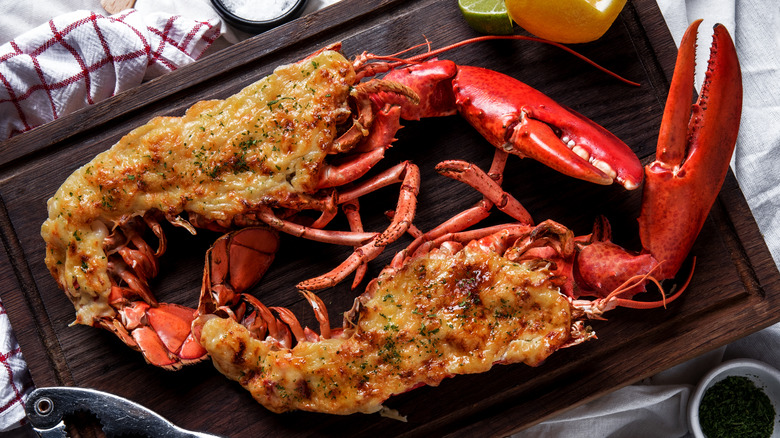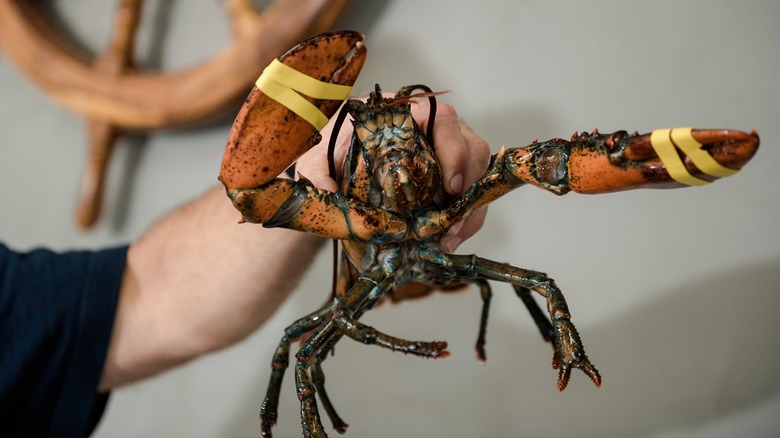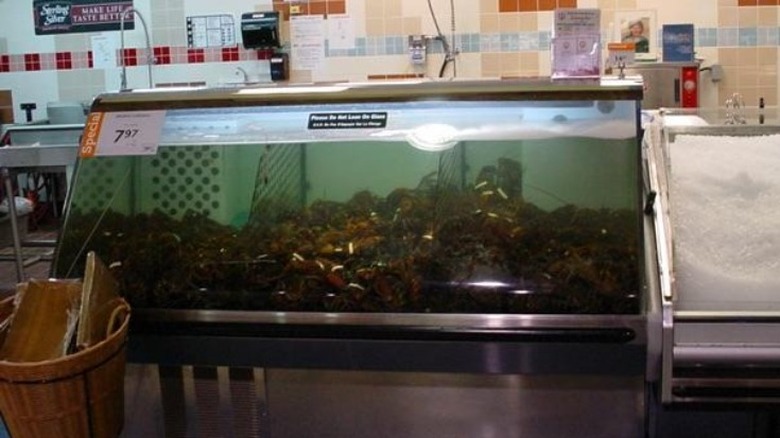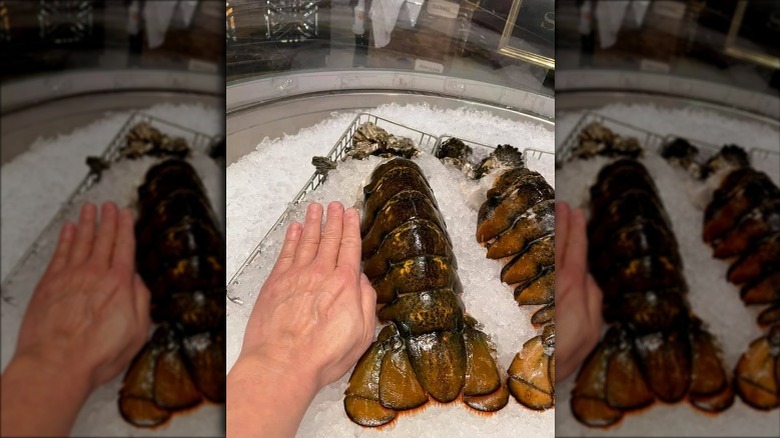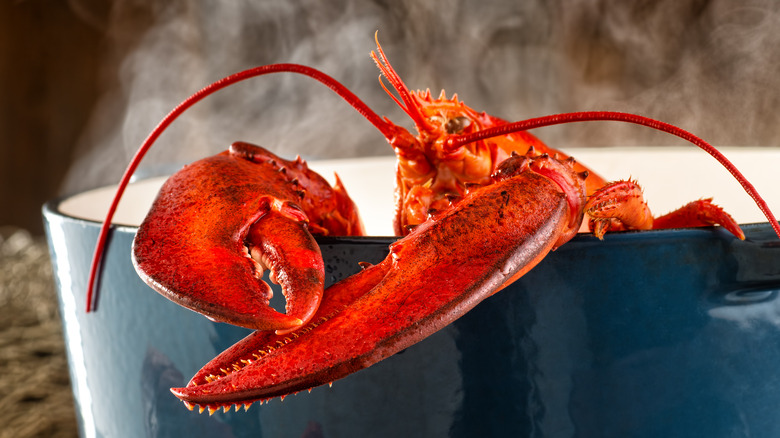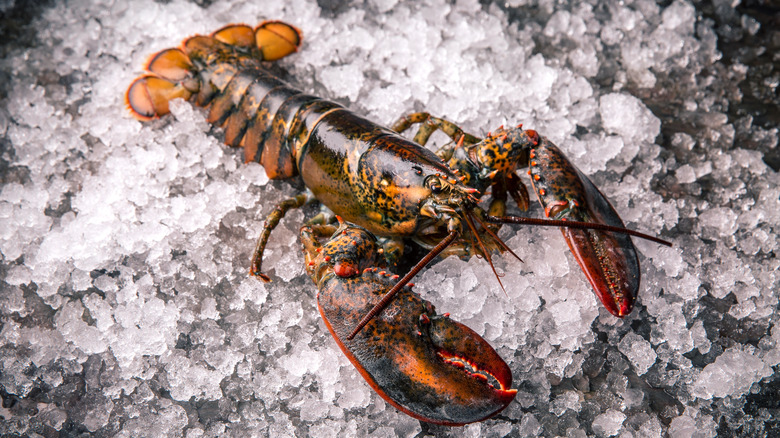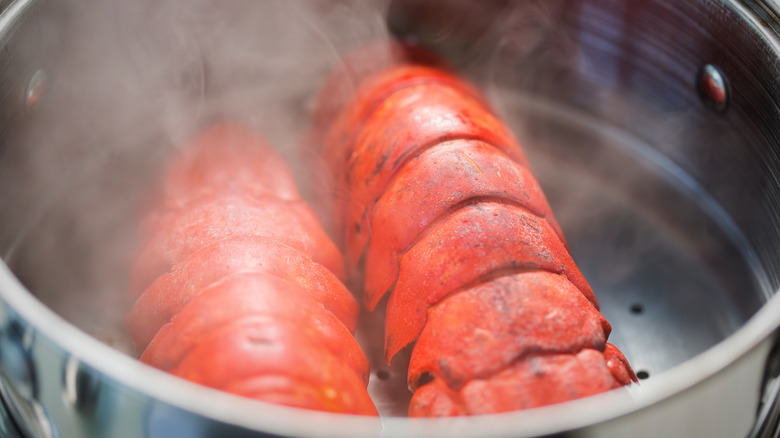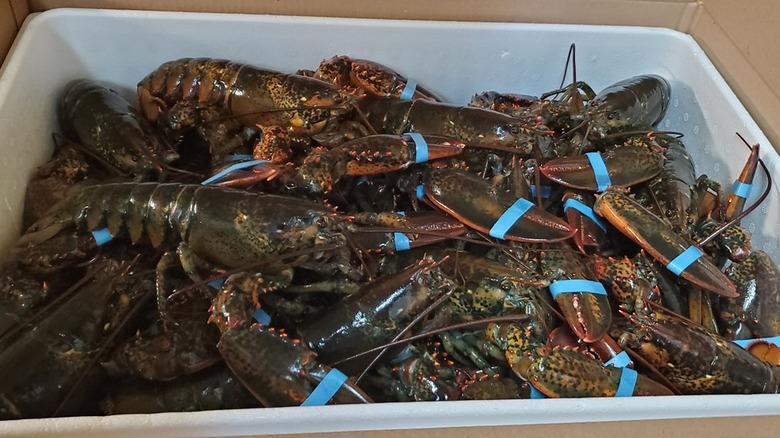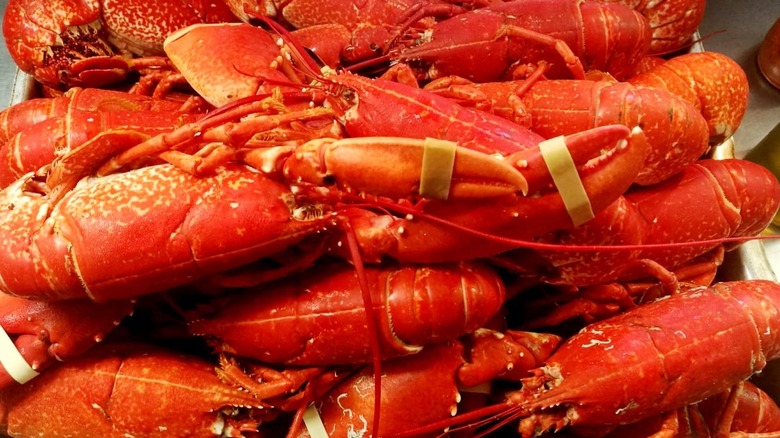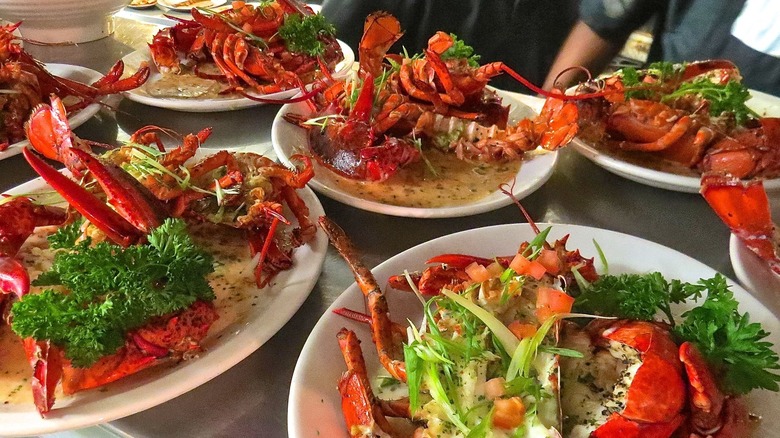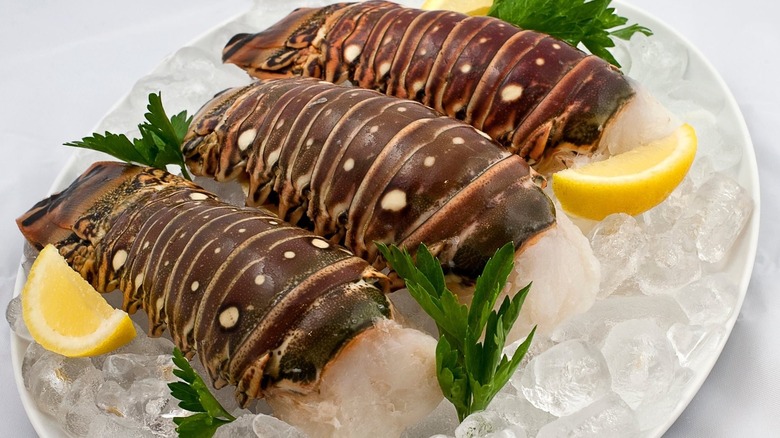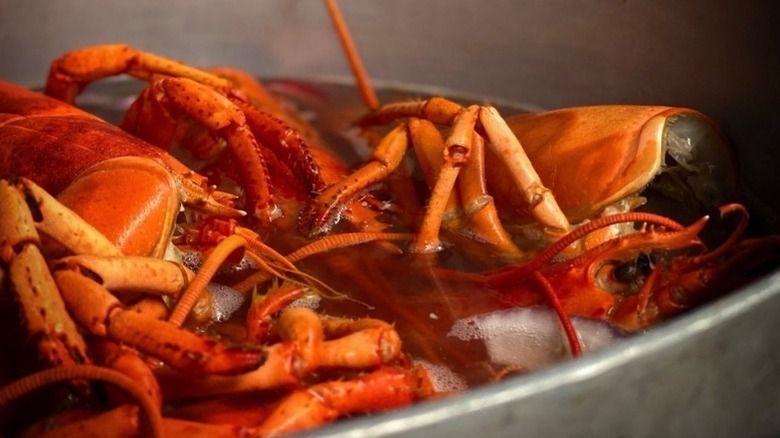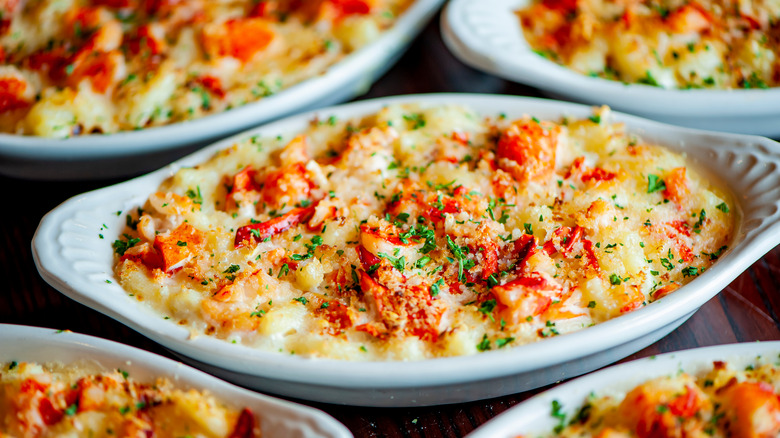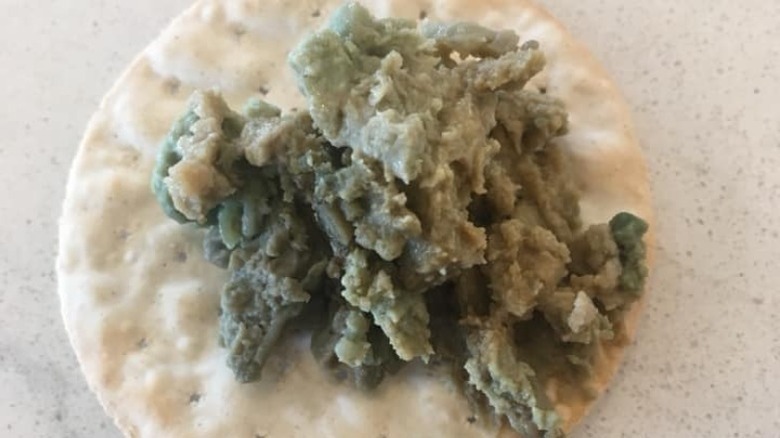Mistakes Everyone Makes When Cooking Lobster
Lobster is now commonly regarded as one of the most luxurious foods you could order on a menu. Though that has not always been the case (History reports that it used to be fed to prisoners and lowly apprentices because it was so cheap), it has now been cemented on fancy restaurant menus as one of the priciest items you can buy. While it's always great ordering lobster at your favorite seafood spot on special occasions, have you ever wondered how you can make this crustacean at home?
We won't lie: Preparing and cooking a lobster can be a challenge, especially if you're not used to cooking with seafood. But if you set your mind to it and follow all the directions for the recipe you're cooking, you should be able to pull it off. However, that cooking process may not be as straightforward as it seems. Even if you think you're doing everything right, you may be making mistakes that can take your lobster from unbelievably tasty to a rubbery, unappetizing mess in mere minutes. And, given how much you've potentially paid for that lobster, that would be a sad meal, indeed.
But don't worry! We're here to help. We've researched some of the most common mistakes people make when they cook lobster so you can make sure to avoid these pitfalls in your own kitchen. Read up, make a mental note (or some paper ones), and get your crustacean cooking the right way.
Getting intimidated before cooking your lobster
Taking on a new cooking challenge may be one of the most exciting things a home cook can do. But cooking a lobster can definitely be more intimidating than some cooking tasks, largely due to the fact that you're likely going to be dealing with a live animal. Sure, it's not exactly the same thing as slaughtering a chicken, but for those who aren't used to handling their food while it's still moving, it can seem daunting. And once you get in front of a real, live lobster that basically looks like a giant sea monster with claws, you may be rethinking your entire menu for the evening.
According to Thrillist, one of the main issues that can throw people off is the color of the lobster. If you've only come across them cooked before, you might assume that they're always that vibrant orange and red color. That's simply not the case, at least not while the lobster is still kicking. They're actually most often a dark greenish color when you buy them live. But you shouldn't let the appearance of these creatures freak you out too much. Once you actually start going through the process, you'll likely realize that it's a lot simpler than you originally thought.
We can all doubt ourselves in the kitchen sometimes, but you shouldn't let that stop you from going forward with your lobster-cooking experiment — you've got this!
Buying your lobster at the wrong place
We've all seen those sad-looking lobsters crawling over each other at our local grocery store. But is that really the best place to buy these crustaceans? According to J. Kenji López-Alt for Serious Eats, not exactly. The best place to buy a lobster is directly from a fisherman, if you know one and have access to one. That way, you know you're going to get a lobster that's as fresh as possible.
Of course, we may not all have a fisherman connection. If that's not possible, then you'll want to instead look for a small-scale fish market. These places often focus on quality and freshness, ensuring you'll be getting the highest-quality product you can as soon as it's out of the ocean. The best place in the country to find these spots are in the Northeast, where lobsters abound. Consider that lobster rolls hail from this region for a good reason, after all.
If you live farther from the coast, though, you may have a difficult time finding fresh lobster near you. In that case, it's generally a good idea to order online. (Yes, they still come live if you choose to do that.) If the worst comes to worst, you can always order pre-steamed lobster meat if you really have to — at least that makes things easier for you, right?
Choosing the largest lobster available
If you're making lobster for a lot of people — or if you're just feeling extra indulgent — then you may be tempted to choose the largest lobster available wherever you're buying it. The bigger, the better, right? Well, when it comes to lobsters, that's not always the case. Here, size isn't everything. In fact, it may be better to choose a smaller lobster in general. First of all, remember that larger lobsters are going to be more expensive. Since this is already a pricy foodstuff, you don't want to overdo it when it comes to your wallet.
But choosing a lobster by its size also comes down to taste. According to HuffPost, larger lobsters are all older lobsters, which means their meat is often tougher and less appetizing. They won't taste as fresh or as tender as younger lobsters, and that's what you really want, isn't it? Instead of looking for a lobster that's over two pounds, it's better to find one that's around a pound and a quarter. That size of lobster should provide you with plenty of meat, while that meat is likely to be higher-quality than it would be if you were to choose a larger one from the tank.
Overcooking your lobster
Perhaps the most common mistake people make when it comes to cooking lobster is overcooking it. This is true of a lot of different types of seafood, which is often more delicate than other types of meat. The fact that many people aren't super familiar with how to prepare it further complicates things. Because of that, you'll want to keep a close eye on the time to ensure that you don't leave it cooking for too long. Doing so could result in a rubbery texture that's going to be less than luxurious, according to GQ.
The actual cooking time comes down to a lot of different factors that you'll want to note, like how large your lobster is, how much of it you're cooking at once, and the cooking method you choose to use. Regardless of how long you decide you need to cook your lobster, we recommend using a timer so you're not just relying on your senses alone. This may take just a little a bit of extra work, but it'll pay off when you finally bite into a juicy, well-prepared piece of lobster meat.
Undercooking your lobster
Overcooking your lobster is generally more of a problem than undercooking it, as seafood cooks so quickly and can turn sadly rubbery as a result. However, the main downside of overcooked lobster is just a less-than-appetizing main course. Undercooking your lobster, on the other hand, is a more serious matter, as it can potentially make you and your guests sick with food poisoning. Therefore, you'll want to take care to ensure that your lobster is cooked all the way through before you consume it.
Fortunately, it's pretty easy to tell if your lobster is cooked, as it largely comes down to color. According to Livestrong, the outside of your lobster's shell should be a nice, rich red color when it's ready to eat. This means that all of the greenish-blue hue should be long gone. More importantly, though, you'll want to look at the lobster meat itself. Does it still look translucent, or has it turned white? You're looking for the latter. If it still looks a bit translucent when you cut it open, that's how you'll know if you need to cook it for longer to ensure it's safe to eat.
Of course, the best way to ensure that any kind of meat is completely cooked through is to use a meat thermometer — it doesn't get much easier than that!
Thinking that boiling your lobster is the only way to cook it
There's a good chance that every time you've seen a lobster cooked in a movie or a TV show, it was being boiled. That is certainly one way to cook it, but many agree that it's not the best method, especially if you aren't cooking a lot of lobster at one time. While it is totally okay to boil a lobster if that's how you want to cook it, this method simply doesn't result in the best flavor possible. Submerging it in water can actually reduce the amount of flavor you get from your lobster (via GQ), which is the last thing you want considering that lobster has a very mild flavor to begin with.
If you're looking for a traditional preparation method in lieu of boiling, then you should try steaming your lobster instead. This is actually easier, as you don't even have to wait for that massive pot of water to boil. When you steam it, you're aiming for around six minutes per pound.
Not killing your lobster before cooking it
Okay, this one comes with a caveat. If you decide to boil your lobster, this won't be a problem — you can put it headfirst into the pot without killing it and the lobster will die quickly, according to Lobster Anywhere. However, if you decide to go with any other cooking method, you'll want to kill it beforehand. After all, as you can guess, putting a live lobster on a grill is probably not a great idea — it's going to fight and. Therefore, you should kill it before you cook it. But how?
According to the BBC, it's actually a lot simpler than you may assume. Many first stun the lobster, often with a 20-minute ice bath, and then finally kill it with a lengthwise knife cut to the head. Does that sound brutal? Sure. But just remember, if you've ever had lobster at a restaurant, someone had to do this for you. Regardless, if this is the kind of thing you get squeamish about, it may be understandably difficult to do. Once you try it a few times, though, you'll realize it's not as difficult to do as you may assume when you're new to preparing lobster.
Crowding your lobster pot
You already know our stance on boiling lobsters, but if that's what you're planning on doing anyway, you need to make sure that you have the right equipment on hand. That's because boiling lobster involves a large pot if you're going to do it right. If you're not cooking much of it, you may not run into a problem — according to New England Today, you can easily cook a lobster or two in a 4 to 5-quart pot. However, if you have more lobsters than that, you're going to need something bigger. As in, quite a bit bigger. Otherwise, the lobster won't cook that quickly and, if your cooking times get thrown off, you could end up with an over- or undercooked lobster. Of course, that's the last thing you want.
So, the size of the pot ultimately depends on how many lobsters you're cooking. New England Today suggests that you find a pot that holds between 16 and 19 quarts of water at a time. This means that you may have to make a special purchase for the occasion, but it'll be worth it when you taste how good your lobster comes out of a properly prepared pot.
Never roasting your lobster
There seem to be some widely accepted methods for cooking lobster, while other techniques aren't used as much. Of course, boiling may seem like the most common, while, as we learned above, steaming is generally preferred if you're going for that clean, fresh lobster taste you already know and love. You can actually grill lobster too, which is perfect for a seafood-centric cookout or just when you're trying to soak up as much of that nice summer weather as you can. But there's one cooking method for lobster that's often overlooked, and we think that needs to change. Did you know you can actually roast your lobster?
Food52 says that there are some serious benefits to cooking your lobster this way. First of all, roasting will cook the meat more slowly, which also means that it cooks more evenly. This is great if you're worried about overcooking your lobster. It also results in much sweeter-tasting meat, which can be a lovely change of pace if you've always had your lobster one way and with one flavor profile. Plus, roasting a lobster just has a touch of classiness and exciting culinary experimentation that you simply can't deny. Give this method a try if you're looking for a whole new lobster-eating experience.
Buying frozen lobster (other than the tail)
There are a lot of different types of seafood that you can buy frozen. In fact, if you're buying from a local grocery store, it might even be better to buy some types of frozen fish because the "fresh" stuff is really just pre-frozen fish that's already been thawed so it can go on display. Therefore, you'll spend less money buying the frozen stuff and you can just thaw it yourself. But when it comes to lobster, in most cases you definitely do not want to be buying it frozen, according to Serious Eats.
Lobsters have an enzyme in their bodies that starts breaking down their own flesh almost as soon as they die. Therefore, you'll pretty much always want to buy your lobster alive when you can. At the very least, you want to make sure that it's just been killed — and we mean just, as in you don't even want to let a few hours go by before you start cooking your fresh lobsetr.
However, there is an exception to this rule. You can actually buy frozen lobster tails, as they can be removed prior to that enzymatic breakdown. This might be a smart way to go if you don't want to cook a whole lobster or you can't find a live one. But really, if you want the best-tasting lobster possible, live ones are always best.
Throwing out lobster shells
We're all on a mission to reduce food waste, right? Or at least, we should be. This means finding alternative ways to use what we generally think of as food "scraps." After you cook your lobster, you may think that the pieces of the shell you remove are good for nothing but the trash or maybe the compost, if that's available in your area. However, throwing away your lobster shells is actually a huge waste of flavor. And since lobster can be so expensive, you really want to make sure you're using as much of it as possible.
That's why HuffPost says that tossing out your lobster shells is one of the biggest lobster-cooking mistakes you can make. Instead of doing that, they suggest sauteing the shells and legs with oil, which will leave you with a super flavorful fat that you can then add to all kinds of dishes. Alternatively, you could also boil the shells and scraps to make a lovely, rich broth that you can use in all types of seafood dishes, starting with classic seafood stews and chowder, for instance. So, don't waste those delicious ingredients! Make something with them that you can enjoy for yet another lobster-infused meal down the road.
Using too many extraneous ingredients
Lobster costs a lot of money for a reason. Its light, fresh taste is unparalleled and it should really be the highlight of your plate. Just think of a traditional lobster roll, which is usually served with either mayo or butter but not a whole lot else. However, if you're used to cooking other types of meat, you may be tempted to add a ton of other ingredients to the dish to up the flavor ante. According to HuffPost, though, this is not the method you should take if you truly want to enjoy your lobster for the unique flavor it brings to the table.
Since lobster is so light, it can easily be covered up by other ingredients. Unless you have a specific dish in mind, you don't need to be mixing a ton of sauces or tossing your lobster with a bunch of subpar ingredients, anyway. Instead, you should just let this fantastic ingredient speak for itself and prepare it with as little culinary competition as possible.
Forgetting to save the tomalley
When you order lobster at a restaurant, you're probably not getting the whole animal. Instead, a chef will likely pick out the most prized pieces and present those to you. But when you get to cook a lobster for yourself at home, you'll notice that there are other nooks and crannies from which you can pull delicious, savory meat. In that spirit, one part of the lobster you may not have tried before if you haven't made it at home is the tomalley. Per Thrillist, tomalley is actually the lobster's liver, which appears as a soft greenish area near the animal's tail.
Tomalley is known for having a super strong flavor and a very creamy texture. Quite a few people in the know really love this part of the lobster, so make sure you don't throw it away when you're done cooking. Instead, save it and give tomalley a try, perhaps served up on some bruschetta or crackers. While some admittedly dislike it, others think that tomalley is one of the best parts of lobster. Who knows? It may become your new favorite too.
